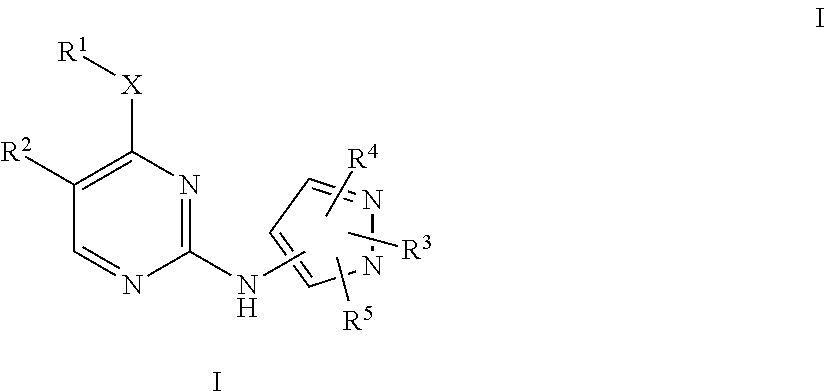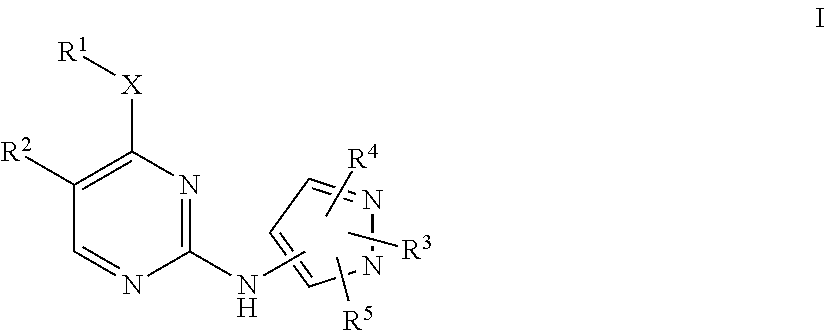Pyrazole aminopyrimidine derivatives as lrrk2 modulators
a technology of aminopyrimidine and pyrazole, which is applied in the direction of biocide, heterocyclic compound active ingredients, drug compositions, etc., can solve the problems of trembling, slow movement, and impaired ability to direct and control the movement of the body
- Summary
- Abstract
- Description
- Claims
- Application Information
AI Technical Summary
Benefits of technology
Problems solved by technology
Method used
Image
Examples
example 1
N2-(1-isopropyl-1H-pyrazol-4-yl)-N4-methyl-5-(trifluoromethyl)pyrimidine-2,4-diamine
[0644]
[0645]To a microwave tube was added 2-chloro-N-methyl-5-(trifluoromethyl)pyrimidin-4-amine (112 mg, 0.53 mmol), 1-isopropyl-1H-pyrazol-4-amine (55 mg, 0.44 mmol), cesium carbonate (0.287 g, 0.88 mmol), XPhos (21 mg, 0.044 mmol), Pd2(dba)3 (20 mg, 0.02 mmol) and dioxane (2.5 mL). The tube was sealed and the reaction was irradiated in the microwave at 140° C. for 30 minutes. The reaction mixture was then filtered and concentrated. The crude product was purified by reverse phase HPLC to give N2-(1-isopropyl-1H-pyrazol-4-yl)-N4-methyl-5-(trifluoromethyl)pyrimidine-2,4-diamine (22 mg, 16%). LCMS (Method A): [MH+]=301.1 at 3.2 min. 1H-NMR (DMSO): δ 9.43 (m, 2H), 8.08 (s, 1H), 7.89 (s, 1H), 7.54 (s, 1H), 6.96 (m, 2H), 4.43 (m, 1H), 2.92 (d, J=8.0, 3H), 1.39 (d, J=6.6, 6H).
[0646]Compounds made using the above procedure are shown in Table 7 below, together with low resolution mass spectrometry (M+H), pr...
example 89
5-Bromo-N2-(1,5-dimethyl-1H-pyrazol-4-yl)-N4-methylpyrimidine-2,4-diamine
[0647]
[0648]To a mixture of 5-bromo-2-chloro-N-methylpyrimidin-4-amine (0.201 g, 0.903 mmol) and 1,5-dimethyl-1H-pyrazol-4-amine (0.12 g, 1.08 mmol) in 2-methoxyethanol (2 mL) was added TFA (0.070 mL, 0.9 mmol). The reaction was stirred in a sealed tube at 100° C. for 90 minutes. The resulting precipitate was collected by filtration. The isolated solid was further purified by reverse phase HPLC to give 5-bromo-N2-(1,5-dimethyl-1H-pyrazol-4-yl)-N4-methylpyrimidine-2,4-diamine (46 mg, 17%). LCMS (Method A): [MH+]=297.0 at 2.57 min. 1H-NMR (DMSO): δ 8.28 (s, 1H), 7.84 (s, 1H), 7.49 (s, 1H), 6.79 (d, J=3.4, 1H), 3.67 (s, 3H), 2.82 (d, J=3.6, 3H), 2.14 (s, 3H). Ki=0.017 uM.
[0649]Compounds made using the above procedure are shown in Table 8 below, together with low resolution mass spectrometry (M+H), proton NMR, and LRRK2 Ki (micromolar) data for selected compounds determined from the assay described below.
TABLE 8Nam...
example 349
2-(1,5-Dimethyl-1H-pyrazol-4-ylamino)-4-(methylamino)pyrimidine-5-carbonitrile
[0650]
[0651]To a mixture of 5-bromo-N2-(1,5-dimethyl-1H-pyrazol-4-yl)-N4-methylpyrimidine-2,4-diamine (95 mg, 0.32 mmol), zinc cyanide (70 mg, 0.60 mmol), Pd2(dba)3 (11 mg, 0.012 mmol), DPPF (13 mg, 0.023 mmol) was added DMF (3.5 mL). The reaction was then heated in a sealed tube at 105° C. for 18 h. The reaction mixture was filtered and concentrated. The crude product was purified by reverse phase HPLC to give 2-(1,5-dimethyl-1H-pyrazol-4-ylamino)-4-(methylamino)pyrimidine-5-carbonitrile (19 mg, 25%). LCMS (Method A): [MH+]=244.1 at 2.53 min. 1H-NMR (DMSO): δ 8.96 (m, 1H), 8.21 (m, 1H), 7.49 (m, 2H), 3.69 (s, 3H), 2.84 (m, 3H), 2.14 (m, 3H). K1=0.025.
[0652]Compounds made using the above procedure are shown in Table 9 below, together with low resolution mass spectrometry (M+H), proton NMR, and LRRK2 Ki (micromolar) data for selected compounds determined from the assay described below.
TABLE 9NameStructure1H...
PUM
| Property | Measurement | Unit |
|---|---|---|
| Volume | aaaaa | aaaaa |
| Volume | aaaaa | aaaaa |
| Volume | aaaaa | aaaaa |
Abstract
Description
Claims
Application Information
 Login to View More
Login to View More - R&D
- Intellectual Property
- Life Sciences
- Materials
- Tech Scout
- Unparalleled Data Quality
- Higher Quality Content
- 60% Fewer Hallucinations
Browse by: Latest US Patents, China's latest patents, Technical Efficacy Thesaurus, Application Domain, Technology Topic, Popular Technical Reports.
© 2025 PatSnap. All rights reserved.Legal|Privacy policy|Modern Slavery Act Transparency Statement|Sitemap|About US| Contact US: help@patsnap.com



